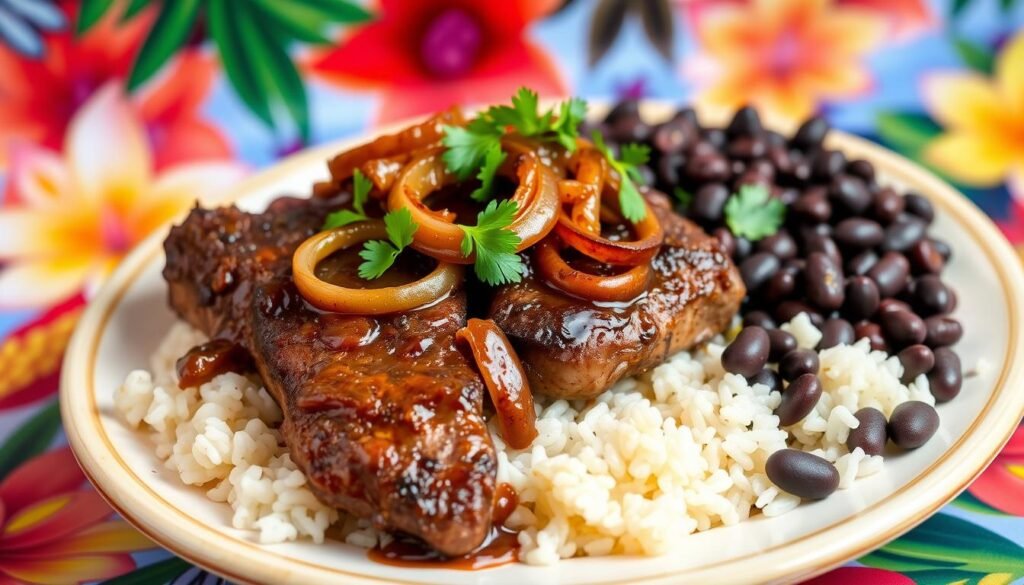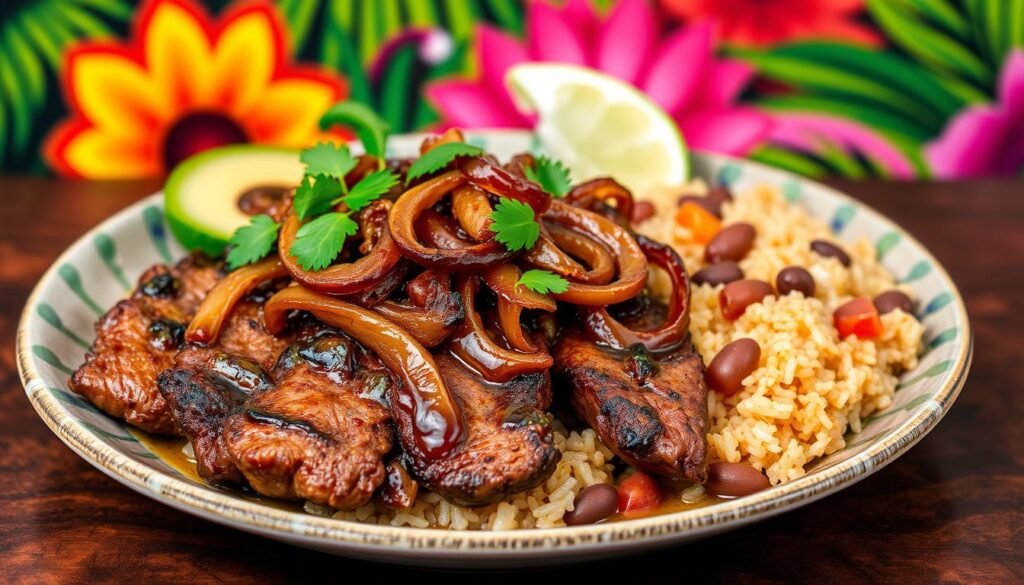Growing up in a Puerto Rican household, the smell of bistec encebollado was always welcome. It would fill the air, inviting everyone to the dinner table. This dish, with tender cube steak in a tomato sauce and caramelized onions, has been a family favorite for years.
Bistec encebollado is more than just a meal. It’s a link to Puerto Rico’s vibrant flavors and rich culture.
Thinking about all the meals we shared, bistec encebollado brings back happy memories. This simple yet tasty dish, with its mix of spices and tender beef, takes me back to my childhood. Those were times when family dinners were special.
Now, making this recipe in my kitchen is not just about food. It’s about connecting with my past and the comfort of home.
Understanding Bistec Encebollado: A Puerto Rican Comfort Classic
Bistec encebollado is a beloved dish in Puerto Rico, known as the island’s “national dish.” It has a rich history, influenced by Spanish cuisine. The name “bistec” comes from the English word “beef steak,” showing how cultures blend through food.
Origins and Cultural Significance
Bistec encebollado is more than food; it’s a tradition that unites families. It’s linked to happy times and memories of childhood. This dish is a favorite in Puerto Rican restaurants in the U.S., especially in New York.
Traditional Family Recipe Heritage
Every family in Puerto Rico has their own version of bistec encebollado. Recipes are passed down, keeping the true flavors alive. They use special spices like cumin and oregano to make the dish unique.
Modern Interpretations
Some chefs in Puerto Rico are trying new things with bistec encebollado. They keep the dish’s heart but add their own twist. This way, the classic remains loved by all, bringing joy to Puerto Rican families everywhere.

Essential Ingredients for Authentic Bistec Encebollado
To make a true Puerto Rican beef dish like Bistec Encebollado, you need the right ingredients. The dish starts with cube steak, which becomes tender when cooked slowly. This steak is the heart of the onion stew.
The sofrito, a mix of herbs, vegetables, and spices, adds a unique Puerto Rican taste. Adobo seasoning, sazon, dried oregano, and vinegar also play a big role. They all mix together to create a complex flavor.
Tomato sauce and chicken bouillon add to the dish’s richness. They make a savory broth that holds everything together. The mix of cube steak, Spanish onions, sofrito, and seasonings makes Bistec Encebollado truly Puerto Rican.
“The secret to a truly authentic Bistec Encebollado is in the balance and harmony of its essential ingredients. Each component plays a vital role in creating the dish’s signature flavor profile.”
By choosing and preparing these key ingredients, anyone can make a Bistec Encebollado that truly captures Puerto Rican flavors. It brings the taste of the island to your kitchen.
Selecting the Perfect Cut of Meat
Choosing the right meat is key to making a great bistec encebollado. The traditional choice is cube steak. It comes from the top round or top sirloin and is tenderized mechanically.
Cube steak is tender and affordable. It makes the bistec encebollado taste amazing. If you can’t find cube steak, round steak or sirloin works well too.
Proper Meat Preparation Techniques
It’s important to prepare the meat right, no matter the cut. Cut the steak into thin strips, about ¼-inch thick. This helps it cook evenly and improves the dish’s texture.
To make the meat even softer, you can tenderize it. Some recipes suggest using a meat tenderizer. This helps soften the tough fibers, making the steak more tender.
“The secret to a truly exceptional bistec encebollado lies in the careful selection and preparation of the meat. With the right cut and a bit of tenderizing, you can unlock the full potential of this Puerto Rican classic.”
The Art of Marination
Marination is key to making your bistec encebollado shine. This Puerto Rican dish combines steak and onions. By soaking the meat in a marinade, it gains a rich taste that seasoning alone can’t match.
The marinade for bistec encebollado is special. It mixes olive oil, vinegar, garlic, oregano, sofrito, and Puerto Rican spices like adobo and sazon. This blend not only boosts the steak’s flavor but also makes it tender. The result is a dish that’s tender and full of taste.
To get the best results, marinate the steak for at least 4 hours. Overnight in the fridge is even better. This long marinating time lets the flavors deeply penetrate the meat, turning it into a true culinary delight.
- Combine the marinade ingredients in a shallow dish or resealable bag.
- Add the steak, making sure it’s fully submerged in the marinade.
- Cover or seal the container and refrigerate for at least 4 hours, or up to 24 hours.
- Flip the steak occasionally to ensure even marination.
The magic of marination is in breaking down tough fibers. This makes the meat tender and flavorful. So, dive into the art of marination and let your bistec encebollado reach its peak.
“Marination is the secret to unlocking the true essence of bistec encebollado. It’s a simple yet transformative step that elevates the dish to new heights of flavor and texture.”
Mastering the Cooking Process
To make the perfect sautéed steak and caramelized onions for Bistec Encebollado, you need to focus on every detail. Understanding the cooking process is crucial. It affects the texture and flavor of your dish.
Temperature Control Tips
For a great sautéed steak, keep the heat high. Start by heating a large skillet or Dutch oven over medium-high. Add the marinated steak and sear until it’s nicely browned on both sides, about 2-3 minutes each side. This step locks in the juices and adds flavor.
Timing and Tenderness Tests
After searing, lower the heat to low and let the steak stew for 40-45 minutes. This makes it fork-tender. Check the liquid often and add water if needed to prevent the onions from burning. To check if the steak is done, use a fork to gently pierce it. It should be soft and almost fall apart.
Achieving Perfect Onion Consistency
- For the caramelized onions, aim for a soft, almost melting texture. Add the sliced onions to the pan after the steak has been searing for 10-15 minutes.
- Cook the onions over medium-low heat, stirring occasionally, until they are soft, sweet, and lightly browned, about 30 minutes.
- Adjust the heat as needed to prevent the onions from burning or drying out. The goal is to achieve a harmonious balance between the tender steak and the caramelized onions.
Mastering the cooking process will help you make a Bistec Encebollado that’s perfect for any Puerto Rican family’s table. Remember, patience and attention to detail are keys to unlocking the full potential of this beloved dish.
Traditional Seasoning and Spice Combinations
Authentic bistec encebollado, the beloved Puerto Rican steak and onion dish, is all about the blend of traditional seasonings. The key to unlocking the distinctive flavor profile lies in the careful selection and harmonious integration of Puerto Rican spices.
At the heart of the seasoning arsenal are a few essential ingredients:
- Adobo: A versatile seasoning blend featuring garlic powder, oregano, black pepper, and other aromatic spices that lend a savory depth to the dish.
- Sazón: A vibrant seasoning mix that includes culantro (also known as recao) and achiote, imparting both color and flavor to the steak.
- Dried oregano: The warm, earthy notes of Puerto Rican oregano complement the other spices perfectly.
Beyond these staple seasonings, sofrito, a flavorful blend of herbs and vegetables, is also a crucial component in traditional Puerto Rican cuisine. The combination of these seasonings creates the signature taste that distinguishes bistec encebollado from other steak dishes.
“The secret to authentic Puerto Rican bistec encebollado lies in the carefully curated blend of spices and seasonings that have been passed down through generations.”
By mastering the art of seasoning, home cooks can unlock the true essence of this beloved Puerto Rican comfort classic. They can transport their taste buds to the vibrant flavors of the island.
Side Dishes and Accompaniments
No Bistec Encebollado (Puerto Rican Steak and Onions) is complete without the perfect accompaniments. It’s usually served with fluffy white rice. This rice soaks up the flavorful sauce well. You can also try yellow rice or arroz con gandules (rice with pigeon peas) for a twist.
Traditional Puerto Rican sides include habichuelas guisadas (stewed beans), tostones (fried green plantains), or maduros (fried sweet plantains). Some people also enjoy a watercress salad or creamy avocado slices. And don’t forget the crusty bread for dipping in that delicious sauce!
Rice Variations
- White rice
- Arroz con gandules (rice with pigeon peas)
- Yellow rice
Traditional Puerto Rican Sides
- Habichuelas guisadas (stewed beans)
- Tostones (fried green plantains)
- Maduros (fried sweet plantains)
- Watercress salad
- Avocado slices
- Crusty bread
“The side dishes are just as important as the Bistec Encebollado itself. They help balance the flavors and create a complete, satisfying meal.”
Tips for Achieving Restaurant-Quality Results
To make a delicious bistec encebollado like a top Puerto Rican restaurant, focus on cooking techniques, flavor enhancement, and texture. First, marinate the meat well. Let it soak up the flavors for at least an hour, or even better, overnight for extra tenderness.
For the flavor, use top-notch sofrito as the base. Making your own sofrito is best, as it adds a true Puerto Rican taste. Make sure to cook the meat at the right temperature to keep it tender and juicy.
- Let the cooked bistec encebollado rest for a few minutes before serving. This lets the flavors mix well.
- For more flavor, some chefs add a bit of red wine to the sauce while cooking.
By following these tips, you’ll make a bistec encebollado that’s as good as the best in Puerto Rican restaurants.
“The secret to a truly exceptional bistec encebollado lies in the details – from the perfect marination to the careful temperature control during cooking. With a little practice, you can bring the flavors of Puerto Rico right to your own kitchen.”
Storage and Reheating Guidelines
Proper storage and reheating are key for leftover steak. They keep your Bistec Encebollado safe and tasty. Follow these steps to enjoy this Puerto Rican dish for days.
For short-term storage, keep Bistec Encebollado in an airtight container in the fridge for 3-4 days. The flavors get better with time, making it a great make-ahead meal. When reheating, add a bit of water to keep it moist. Heat it gently on the stovetop or in the microwave until it’s hot all the way through.
For longer storage, freeze Bistec Encebollado for up to 3 months. Cool it down first, then put it in a freezer-safe container or bag. To thaw, place it in the fridge overnight. Then, reheat it on the stovetop or in the microwave.
“Proper food safety is essential when storing and reheating any cooked dish, especially those containing meat. Always follow the recommended guidelines to ensure you enjoy your Bistec Encebollado at its best.”
By following these tips, you can enjoy Bistec Encebollado for days. It’s a convenient and tasty meal prep option.
Common Cooking Mistakes to Avoid
Perfecting Bistec Encebollado, a classic Puerto Rican dish, requires avoiding common mistakes. Don’t overcook the meat, as it can become tough. Also, make sure to season it well to avoid a lackluster taste.
Another mistake is not marinating the meat long enough. This can make the meat less tender and less flavorful. Always marinate it for the recommended time to get the best taste.
Choosing the right meat is also key. Avoid using lean cuts that can dry out during slow cooking. Instead, use cube steak or a well-marbled cut that stays juicy.
Onions are crucial in Bistec Encebollado, but don’t overcook them. You want them to have some texture, not be mushy. Let the dish simmer slowly to let the flavors meld together.
Lastly, don’t add too much liquid. It can water down the rich flavors of the dish. The sauce should just coat the meat and onions, not overwhelm them.
“Mastering the art of Bistec Encebollado is all about striking the right balance – tender meat, perfectly caramelized onions, and a sauce that enhances rather than overpowers the dish.”
By avoiding these common mistakes, you’ll make a delicious Bistec Encebollado. It will be a true taste of Puerto Rico, full of vibrant flavors.
Conclusion
Bistec encebollado is more than a meal; it’s a window into Puerto Rico’s rich culture and family traditions. This dish combines simple ingredients with deep flavors, offering a true taste of Puerto Rico. It’s a way to explore Puerto Rican cuisine or connect with your roots.
By learning about bistec encebollado, we’ve discovered its history, how it’s made, and its cultural importance. Knowing the key ingredients and cooking methods lets you make this dish at home. This connects you to Puerto Rico’s lively food culture and family history.
Bistec encebollado is more than a meal; it’s a celebration of Puerto Rican identity and culture. It shows the island’s strength and connects families through cooking. Embrace this recipe to remember Puerto Rico’s diverse cuisine and the lasting power of family traditions.
tostones



